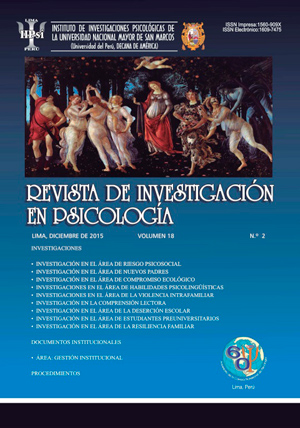Personality, intelligence, motivation and learning strategies in students of the CEPRE-UNMSM; 2013 entrants to San Marcos National University
DOI:
https://doi.org/10.15381/rinvp.v18i2.12088Keywords:
personality, intelligence, motivation, learning strategies, students of CEPREUNMSMAbstract
The present study, of descriptive nature, non experimental and cross-sectional, describes the dimensions of personality, intelligence, motivation and also learning strategies in 553 students of the CEPRE-UNMSM using Eynseck Personality Inventory Form B, D-70 Test and MSLQ-SF Questionnaire. The results indicate that the freshmen 2013 San Marcos tend to sanguine, because the G factor of intelligence places them in the top category, they have moderate anxiety and use, to learn, mostly using cognitive and metacognitive strategy development in resource management strategy better manage self-regulation effort and value components are intrinsically oriented to your goals. The purpose is to identify the psychological profile of the students, this allows the formulation of programs to orientate and/or reorientate the academic tasks of pre-university students.Downloads
Published
Issue
Section
License
Copyright (c) 2015 Hilda J. Chávez Ch., José Chávez Z., César Alvites R., José Vega G., Jesús E. Ruelas S., Miguel Gómez B., Christian Espinoza M., Juan Gómez Ch., Jenifer Challco H., Fabiana Santiago A., Luis Izquierdo Ch.

This work is licensed under a Creative Commons Attribution-NonCommercial-ShareAlike 4.0 International License.
THE AUTHORS RETAIN THEIR RIGHTS:
a. The authors retain their trademark and patent rights, and also on any process or procedure described in the article.
b. The authors retain the right to share, copy, distribute, execute and publicly communicate the article published in the Journal of Research in Psychology (for example, place it in an institutional repository or publish it in a book), with acknowledgment of its initial publication in the Journal of Research in Psychology.
c. Authors retain the right to make a subsequent publication of their work, to use the article or any part of it (for example: a compilation of their work, lecture notes, thesis, or for a book), provided that they indicate the source. of publication (authors of the work, magazine, volume, number and date).






